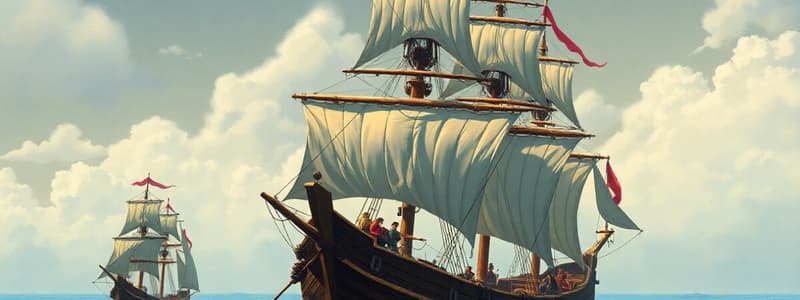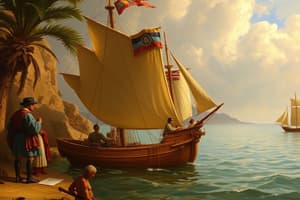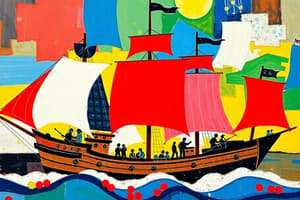Podcast
Questions and Answers
What was the primary purpose of Cartier's expeditions?
What was the primary purpose of Cartier's expeditions?
- To colonize Newfoundland permanently
- To establish trade routes with Indigenous peoples
- To document the flora and fauna of Canada
- To find a Northwest Passage to Asia (correct)
Which event marked a significant conflict with Indigenous people during Cartier's first voyage?
Which event marked a significant conflict with Indigenous people during Cartier's first voyage?
- The planting of a cross on the Gaspe Peninsula (correct)
- The introduction of European diseases
- The search for gold and gems
- The kidnapping of the Haudenosaunee Chief's sons
What incident forced Cartier and his crew to spend the winter in Canada during his second voyage?
What incident forced Cartier and his crew to spend the winter in Canada during his second voyage?
- Indigenous attacks
- A scurvy outbreak (correct)
- Harsh weather conditions
- A food shortage
What mythical city did a Haudenosaunee chief tell Cartier about during his second voyage?
What mythical city did a Haudenosaunee chief tell Cartier about during his second voyage?
What was one outcome of Cartier's explorations in the Gulf of St. Lawrence?
What was one outcome of Cartier's explorations in the Gulf of St. Lawrence?
What was the outcome of John Cabot's first voyage in 1496?
What was the outcome of John Cabot's first voyage in 1496?
What significant event occurred as a result of John Cabot's second voyage in 1497?
What significant event occurred as a result of John Cabot's second voyage in 1497?
What was one of the central motives for Europeans wanting to find a new route to Asia?
What was one of the central motives for Europeans wanting to find a new route to Asia?
Which of the following statements is true regarding the Beothuk people?
Which of the following statements is true regarding the Beothuk people?
What led to the extinction of the Beothuk people?
What led to the extinction of the Beothuk people?
How did King Henry VII contribute to John Cabot's expeditions?
How did King Henry VII contribute to John Cabot's expeditions?
What was Jacques Cartier's primary goal during his early expeditions?
What was Jacques Cartier's primary goal during his early expeditions?
What happened during John Cabot's third voyage in 1498?
What happened during John Cabot's third voyage in 1498?
What significant event marked the end of the Elizabethan Era?
What significant event marked the end of the Elizabethan Era?
Which explorer is known for founding the city of Quebec?
Which explorer is known for founding the city of Quebec?
What was the outcome of the battle of Lützen on November 16, 1632?
What was the outcome of the battle of Lützen on November 16, 1632?
Which countries invaded Germany during the later phases of the Thirty Years War?
Which countries invaded Germany during the later phases of the Thirty Years War?
What role did Samuel de Champlain hold when he returned to Quebec under the Treaty of Saint-Germain in 1632?
What role did Samuel de Champlain hold when he returned to Quebec under the Treaty of Saint-Germain in 1632?
Which Native American tribes did Samuel de Champlain have contact with before coming to Canada?
Which Native American tribes did Samuel de Champlain have contact with before coming to Canada?
What was one of the significant impacts of Samuel de Champlain's voyages?
What was one of the significant impacts of Samuel de Champlain's voyages?
What significant cultural work did Samuel de Champlain create?
What significant cultural work did Samuel de Champlain create?
Flashcards
Cartier's First Voyage
Cartier's First Voyage
Jacques Cartier's first voyage in 1534 aimed to find the Northwest Passage, a route from North America to Asia. He explored the Gulf of St. Lawrence, Quebec, and Newfoundland, planting a cross on the Gaspe Peninsula which caused some tension with the Indigenous Mi'kmaq people.
Cartier's Second Voyage
Cartier's Second Voyage
During his second voyage in 1535-1536, Cartier sailed deeper into Canada, reaching Stadacona (future Quebec City) and Hochelaga (future Montreal). He believed he had found the Northwest Passage but was stopped by rapids. He spent the winter there, battling scurvy, and had to rely on Indigenous remedies for survival.
Cartier's Third Voyage
Cartier's Third Voyage
Cartier's third voyage in 1540 aimed to establish a permanent French colony in Canada. He sailed down the St. Lawrence River but faced hostility from the Haudenosaunee. The settlement was abandoned in 1542 and completely abandoned in 1543.
Cartier's Legacy
Cartier's Legacy
Signup and view all the flashcards
Cartier's Impact on Indigenous Populations
Cartier's Impact on Indigenous Populations
Signup and view all the flashcards
Who was John Cabot?
Who was John Cabot?
Signup and view all the flashcards
What happened during John Cabot's first voyage?
What happened during John Cabot's first voyage?
Signup and view all the flashcards
What were the key findings and results of John Cabot's second voyage?
What were the key findings and results of John Cabot's second voyage?
Signup and view all the flashcards
What happened on John Cabot's third voyage?
What happened on John Cabot's third voyage?
Signup and view all the flashcards
Who were the Beothuk, and what was the nature of the conflict?
Who were the Beothuk, and what was the nature of the conflict?
Signup and view all the flashcards
Why were the French interested in exploring North America?
Why were the French interested in exploring North America?
Signup and view all the flashcards
Who was Jacques Cartier, and what was his role in exploration?
Who was Jacques Cartier, and what was his role in exploration?
Signup and view all the flashcards
What was the significance of Jacques Cartier's expeditions?
What was the significance of Jacques Cartier's expeditions?
Signup and view all the flashcards
Elizabethan Era Ends
Elizabethan Era Ends
Signup and view all the flashcards
Thirty Years War
Thirty Years War
Signup and view all the flashcards
Start of Slavery
Start of Slavery
Signup and view all the flashcards
Who is Samuel de Champlain?
Who is Samuel de Champlain?
Signup and view all the flashcards
Champlain's Encounters
Champlain's Encounters
Signup and view all the flashcards
Champlain's First Voyage
Champlain's First Voyage
Signup and view all the flashcards
Champlain's Legacy
Champlain's Legacy
Signup and view all the flashcards
Champlain's Capture
Champlain's Capture
Signup and view all the flashcards
Study Notes
Columbus's Voyages and European Exploration
- Columbus landed in South America, encountering the Aztecs.
- Europeans sought a new trade route to Asia, as the Silk Road was becoming dangerous.
- Giovanni Caboto (John Cabot) was an Italian explorer, originally from Genoa, who sought a new route for Great Britain and was granted a patent in 1496 to explore lands for the British Crown.
John Cabot's Voyages
- Cabot had three voyages.
- His first voyage (1496) failed due to bad weather.
- His second voyage (1497) was successful, landing in Newfoundland and Labrador, and discovering abundant codfish.
- He was disappointed that he did not find a route to Asia but instead discovered a fishing ground.
- This led to increased European interest in North America.
- Cabot's voyages resulted in increased contact between Europeans and Indigenous peoples, leading to trade, disease, and conflict.
Impact of European Contact
- Increased contact with Indigenous people, initiated by European explorers, led to trade, but also increased disease and conflict among Indigenous peoples.
- European demand for resources encouraged exploitation and conflict.
- The Beothuk people became extinct.
Explorers, Colonization, and Canada
- European explorers looked for a Northwest Passage to Asia via Canada, but this route did not exist.
- Explorers established settlements in North America.
- The French explored and began to claim territory in what is now Canada.
- Jacques Cartier was an explorer in the employ of France, seeking the Northwest Passage and exploring the Saint Lawrence River.
- Colonization efforts resulted in clashes between Europeans and Indigenous peoples over land and resources.
Samuel de Champlain
- A French explorer, navigator, and geographer and known as the "father of New France"
- Founded Quebec City and explored the Great Lakes.
- He formed alliances with some Indigenous groups and had conflict with other groups.
- His voyages led to further settlement and expansion of French influence in North America.
Studying That Suits You
Use AI to generate personalized quizzes and flashcards to suit your learning preferences.



